5.4 Complex Carbohydrates
Complex carbohydrates are polysaccharides, long chains of monosaccharides that may be branched or not branched. The complex carbohydrates you will learn about in this book are all composed solely of glucose. You can think of these as long chains of glucose. There are three main groups of polysaccharides: starch, glycogen, and fiber.
Figure 5.7 Complex Carbohydrates
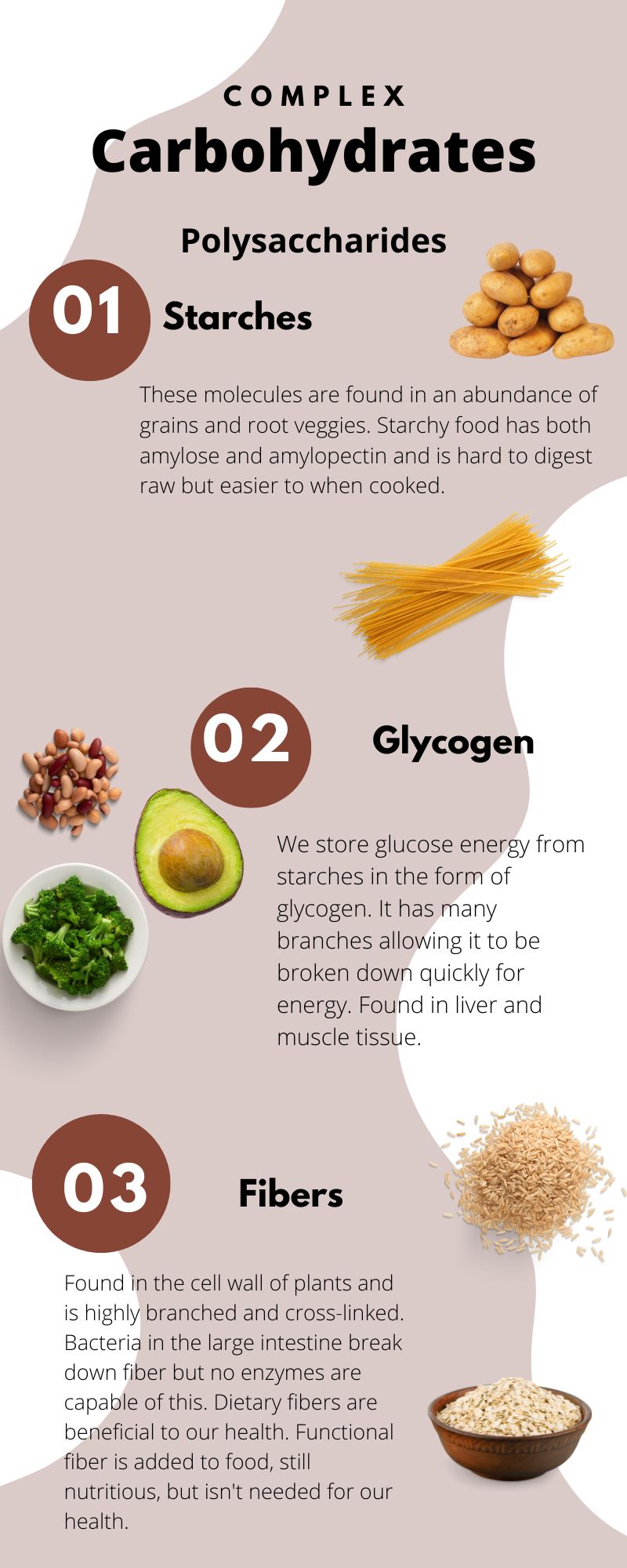
Starch
Starch molecules are found in abundance in grains, legumes, and root vegetables, such as potatoes. Amylose, a plant starch, is a linear chain containing hundreds of glucose units. Amylopectin, another plant starch, is a branched chain containing thousands of glucose units. These large starch molecules form crystals and are the energy-storing molecules of plants. These two starch molecules (amylose and amylopectin) are contained together in foods, but the smaller one, amylose, is less abundant. Eating raw foods containing starches provides very little energy as the digestive system has a hard time breaking them down. Cooking breaks down the crystal structure of starches, making them much easier to break down in the human body.
Glycogen
Humans and animals store glucose energy obtained from starches in the form of the very large molecule called glycogen. Glycogen has many branches that allow it to break down quickly when energy is needed by cells in the body. It is predominantly found in liver and muscle tissue in animals (including humans).
Figure 5.8 Chemical Structures of Starch and Glycogen
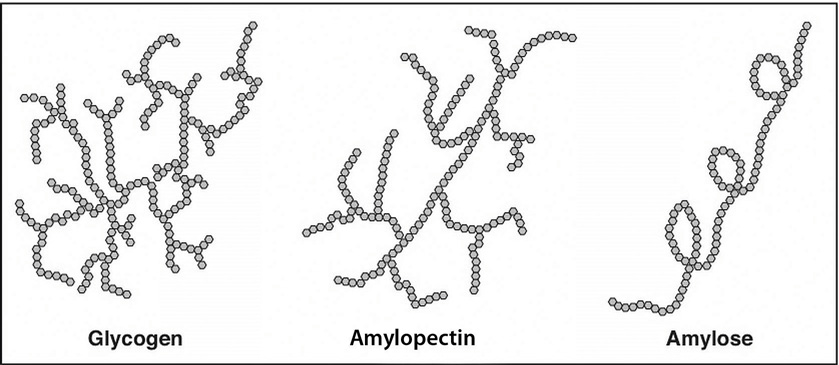
Fiber
Dietary fibers are polysaccharides that are highly branched and cross-linked. Some dietary fibers are pectin, gums, cellulose, and hemicellulose. Fiber is found in the cell wall of plants and non or minimally processed plants are good sources of dietary fiber. Humans do not produce the enzymes that can break down dietary fiber; however, bacteria in the large intestine (colon) do. Dietary fibers are very beneficial to our health. The Dietary Guidelines Advisory Committee states that there is enough scientific evidence to support that diets high in fiber reduce the risk for obesity and diabetes, which are primary risk factors for cardiovascular disease (1).
Dietary fiber is categorized as either soluble or insoluble. Soluble fiber turns into a viscous substance when combined with water in the GI tract. It slows down digestion in the stomach and small intestine and is fermented by bacteria in the colon. Insoluble fiber is largely not digested by human enzymes or bacteria in the gut. Insoluble fiber can hold on to water in the colon and help strengthen the muscles of the colon. Both of these functions lead to reduced “transit time” in the colon.
The last class of fiber is functional fiber. Functional fibers have been added to foods and have been shown to provide health benefits to humans. Functional fibers may be extracted from plants and purified or synthetically made. An example of a functional fiber is psyllium-seed husk. Scientific studies show that consuming psyllium-seed husk reduces blood-cholesterol levels and this health claim has been approved by the FDA. Total dietary fiber intake is the sum of dietary fiber and functional fiber consumed.
Fiber and Health
Even though humans lack the enzymes to digest fiber, there are many health benefits provided by both dietary and functional fiber. One way that fiber impacts your health on a daily basis is the regularity and ease of your bowel movements. Diets with adequate amounts of fiber are associated with regular bowel movements with a healthy consistency that can be passed without straining. Low-fiber diets may result in hard, infrequent bowel movements that are difficult to eliminate which is known as constipation. The straining that occurs with constipation puts pressure on the wall of the colon and causes tiny “sacs,” called diverticula, to form as seen in Figure 5.9. Another contributing factor to the formation of diverticula is the lack of muscle tone in the large intestine. If you remember from chapter 4, your gastrointestinal tract is a hollow tube of muscle. Similar to the other muscles in your body, the muscles that make up your colon will become weaker and not work as well if they are not used very often. Some types of fiber attract water into the intestine causing the fiber and feces to swell and soften. This puts pressure on the inside of the intestinal wall stimulating the muscles to contract. You can think of this as resistance training for your colon! In addition, the softened stool is easier to eliminate.
Figure 5.9 Diverticula on Colon
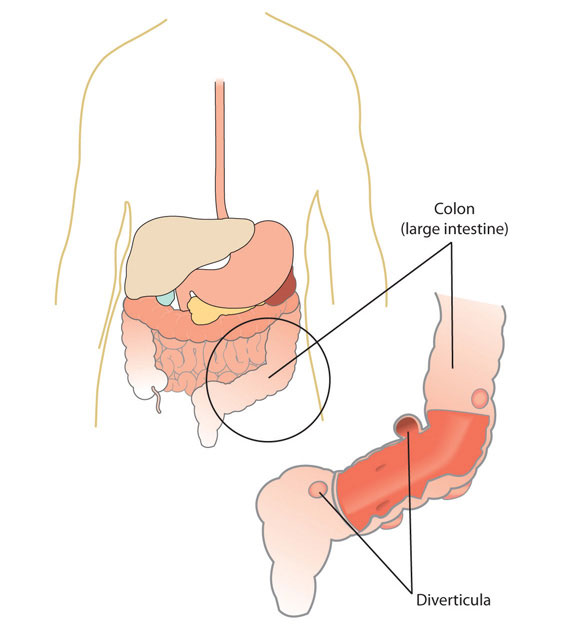
Most of the time, diverticula do not produce symptoms, and you may not even know they are there, but they can become inflamed when food particles, bacteria, or feces get trapped inside them. This condition is called diverticulitis, depending on the severity, it may be necessary to remove the damaged part of the large intestine if this occurs. Another condition that can occur when a person is constipated and straining to pass bowel movements is hemorrhoids. Hemorrhoids are swollen veins in the rectum that tend to bleed. They may or may not cause pain or discomfort depending on the severity. Although hemorrhoids are not a serious health problem they can be quite uncomfortable for some people and occasionally need to be surgically removed.
Diets high in fiber, particularly soluble fiber, can reduce the risk of heart disease by reducing blood cholesterol levels. Soluble fiber binds with cholesterol like glue and prevents cholesterol from being absorbed in the small intestine. Cholesterol is also a component of bile which helps with fat digestion. Generally, the bile is reabsorbed back into the blood to be recycled, however, soluble fibers interfere with this re-absorption by binding with the cholesterol part of bile so it is excreted in the feces. The liver then has to remove cholesterol from the blood to make new bile. In addition, short chain fatty acids that are produced when gut bacteria ferment certain types of fiber may be absorbed and circulate to the liver where the short chain fatty acids may inhibit cholesterol synthesis.
A diet that is high in fiber is, most likely, high in fruits, vegetables, legumes, and whole grains. These foods are also naturally low in added sugars, fat, and calories. The added bulk of the fiber also has beneficial effects on appetite and glucose absorption. First, the bulkiness of fiber stretches out the stomach and sends chemical signals to the brain signaling fullness. This also contributes to satiety and may help reduce caloric intake. Second, fiber slows gastric emptying or the rate at which food leaves the stomach and enters the small intestine. The reduced rate of gastric emptying increases satiety, leaving you feeling fuller longer and slows the rate of glucose absorption in the small intestine, as shown below in Figure 5.10. Because glucose is absorbed at a slower rate when paired with fiber, fiber can play a role in managing blood glucose levels and can help improve insulin sensitivity. This slower rise in blood sugar can help prevent large spikes in blood sugar immediately after a meal followed by a crash a few hours later. Because of these effects, consuming adequate amounts of fiber may play a role in the treatment and prevention of obesity and obesity-related chronic diseases such as diabetes.
Figure 5.10 Difference in Blood Glucose Response After High and Low Fiber Meals
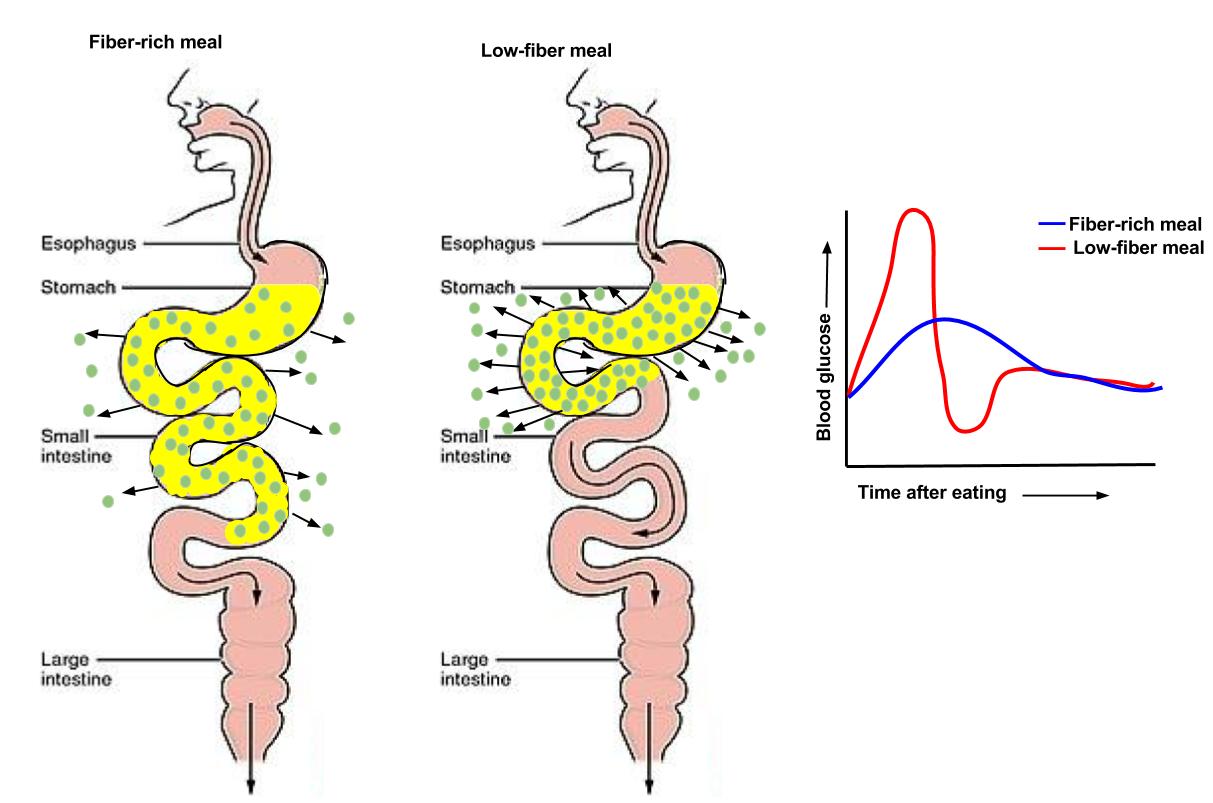
In 2020, breast cancers were the most common and colorectal cancers were the fourth most common type of cancer in the US (5). Diets with adequate amounts of fiber have been associated with lower rates of both breast and colorectal cancer. However, as fiber is found in whole grains, fruits, vegetables, legumes, nuts, and seeds, it is unknown if the protective benefits come directly from fiber, or from phytochemicals or other compounds found in high fiber foods. Most likely it is a combination of factors. There are several theories of how fiber may reduce risk of these types of cancer. For breast cancer, properties of fiber that help regulate blood sugar and improve insulin sensitivity may also help reduce risk of breast cancer. It is also possible that fiber can affect the composition of the gut microbiome to modulate sex hormones and reduce circulating estrogen levels (6). For colon cancer, regularity of bowel movements related to adequate fiber intake can reduce the transit time of fecal matter through the colon. This reduced transit time decreases the amount of time that carcinogens may have to interact with intestinal cells. Finally, soluble fibers may bind with carcinogens, so that they are excreted in the feces, again reducing the risk of cancer.
5.11 Tips to Increase Your Fiber Intake
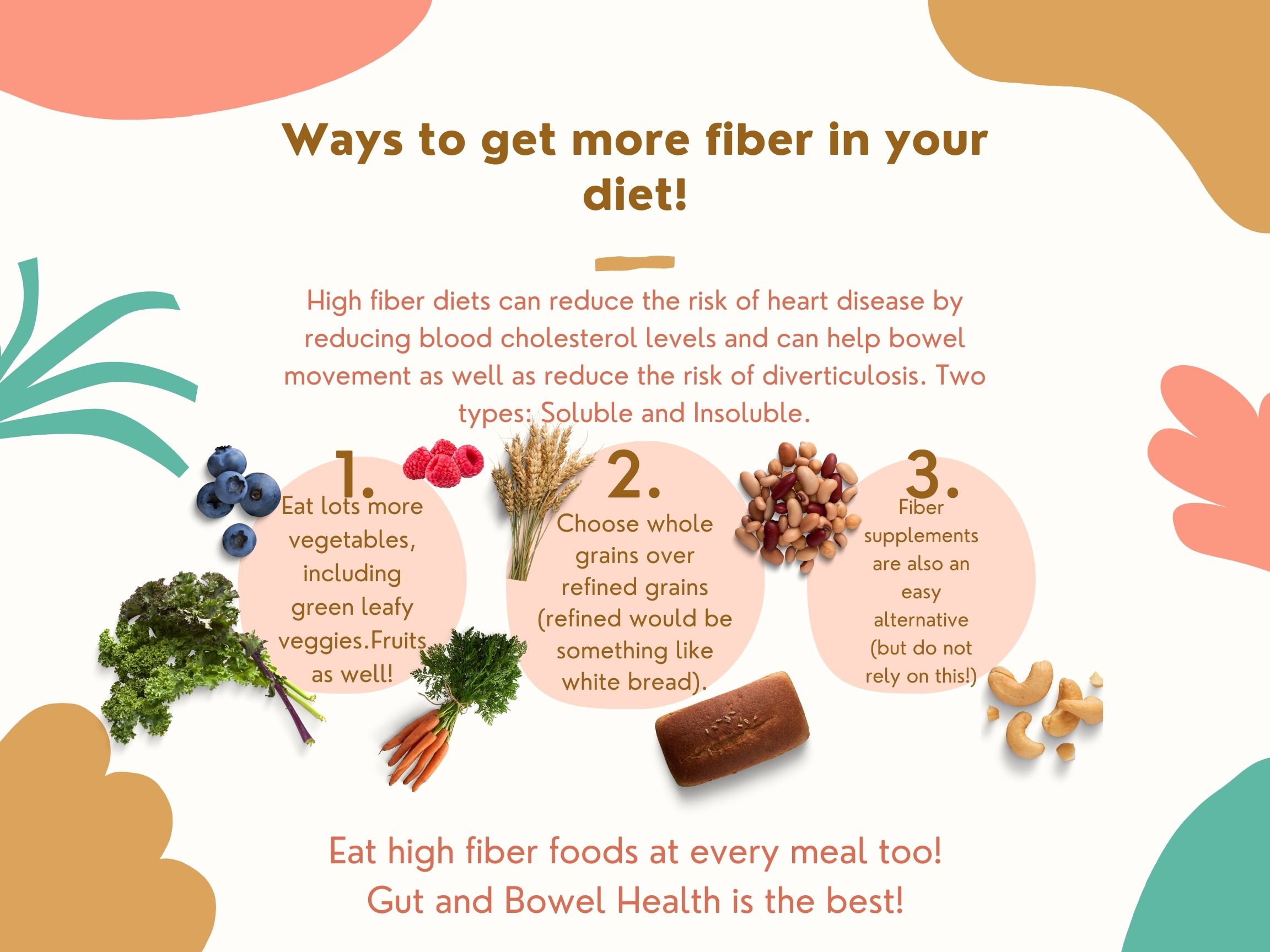
Whole Grains
Whole grains are an important component of a healthy diet because they contain fiber along with many vitamins and minerals. A grain contains 3 distinct parts: the bran, the germ, and the endosperm. The bran is the fibrous outer layer of the grain that contains most of the fiber as well as many B-vitamins and minerals. The germ is the part of the plant that helps promote reproduction and contains healthy fats as well as vitamins and phytochemicals. The endosperm is the starchy part of the grain and contains lots of carbohydrate as well as some protein and small amounts of vitamins. If you consume a whole grain product, you are getting the energy from the endosperm along with the nutrients and fiber found in the bran and germ. However, most grain products sold in the US have been refined. During this refining process, the germ and bran are removed and many of the nutrients that were initially present in the grain are lost. Eating too many refined grains can make it difficult for an individual to meet their nutrient goals while staying within their calorie range. This is why the Dietary Guidelines for Americans recommends that a minimum of all grains consumed should be whole grains.
If you remember from chapter 2, enrichment is when nutrients are removed during processing and added back in before the food product is sold. Many refined grains sold in the US are required by law to be enriched with five nutrients: thiamin, riboflavin, niacin, folate, and iron. This ensures that individuals who consume primarily enriched grain products will obtain certain essential nutrients, many other nutrients and fiber that are removed during processing are not added back in so whole grains are considered the most nutrient dense form of grains.
When you think of whole grains, whole wheat may be the first thing that comes to mind. Whole wheat is a whole grain but many other grains are whole grains too.
Sources of Whole Grains
- Whole wheat breads, pastas, crackers, tortillas
- Brown or wild rice
- Oats
- Popcorn
- Quinoa
- Millet
- Spelt
- Amaranth
- Whole or dark rye
- Barley
- Buckwheat
- Muesli
- Whole grain cornmeal
Figure 5.12 provides some tips for increasing your whole grain consumption.
Figure 5.12 Whole Grains
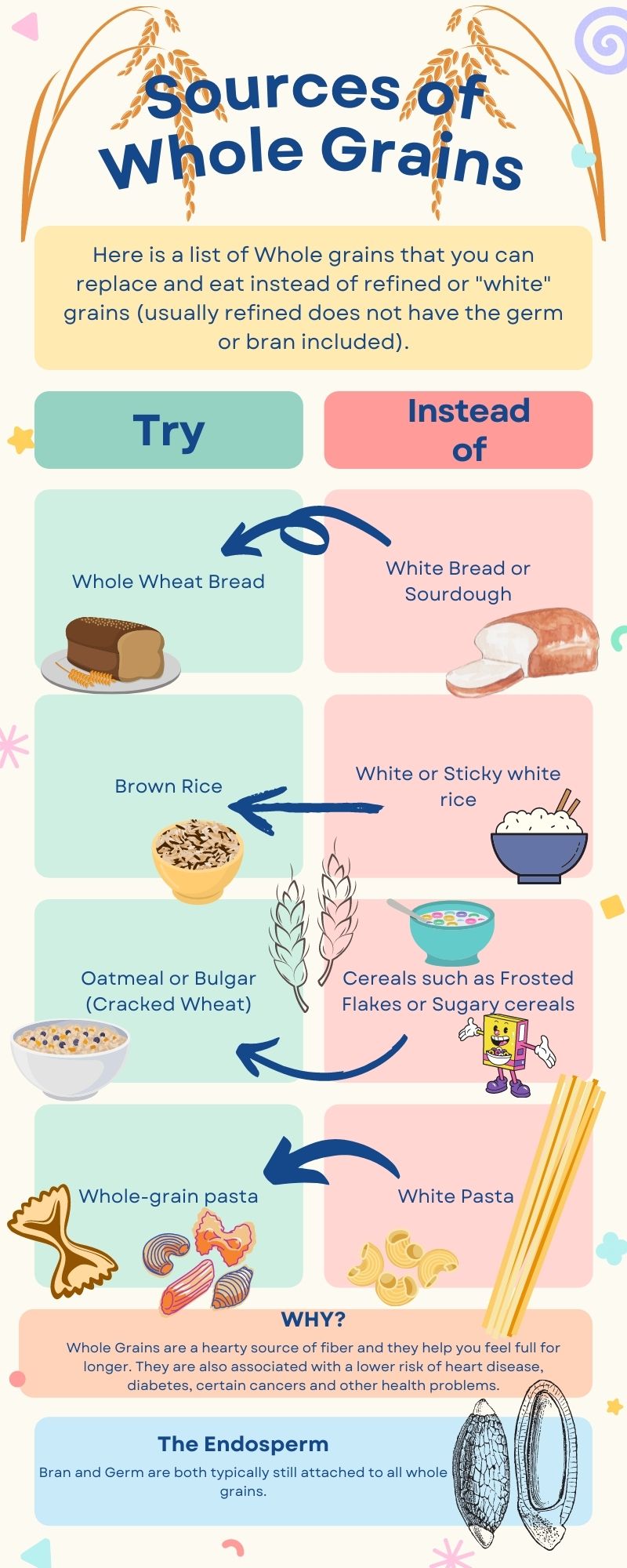
Media Attributions
- Complex Carbohydrate © Natalie Fox is licensed under a CC BY (Attribution) license
- Chemical Structures of Starch and Glycogen © University of Hawaii is licensed under a CC BY (Attribution) license
- Diverticular Disease © University of Hawaii is licensed under a CC BY-NC-SA (Attribution NonCommercial ShareAlike) license
- Fiber and Diabetes © Allison Calabrese is licensed under a CC BY (Attribution) license
- Ways to get more fiber in your diet! © Natalie Fox is licensed under a CC BY (Attribution) license
- Whole Grains © Natalie Fox is licensed under a CC BY (Attribution) license
